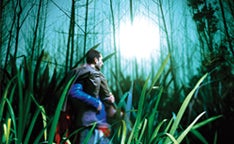The People Behind The Pics: Alejandro Chaskielberg
American Photo: The Argentinean photographer turns documentary subjects into fine-art photography.



Argentinean photographer Alejandro Chaskielberg doesn’t care much for limitations, and his blindness to boundaries can now be classified as award winning. Chaskielberg’s project The High Tide, for which he received the 2009 Burn Emerging Photographer Grant, documents the life and work of natives and émigrés in the Paraná River Delta.
For The High Tide, Chaskielberg joined workers in their fishing and logging labors in the delta, a wetland in eastern Argentina, about 20 miles north of Buenos Aires, to gain an understanding of the people (some of whom had never been photographed) and their connection to their surroundings. The isolated (but not primitive) culture of “islanders” who work the land inhabit the archipelago carved out by the Paraná and its many arms. “The Paraná River supplies water for more than 100 million people, including the cities of San Pablo, Buenos Aires and Asunción. My photographs set out to document the life and work of the islanders.”
But what might seem like a straightforward photojournalism concept, Chaskielberg has captured in dreamlike imagery, reminiscent of the magical realism movement in literature and film. “I am interested in the poetic and visual power of the water, and I try to give a magical view of people in their environment,” he says. In many shots, which have a voyeuristic feel, the full moon seems to light the world as brightly as the sun.
Chaskielberg’s interest in photography began when, at 10 years old, his friends gave him his first camera — a plastic 126mm Kodak. His initial fascination was with the technology itself. “From the beginning I tried to understand what was happening inside the camera,” he says. He currently shoots with a 4×5 Sinar Norma, using its tilts and swings to achieve a surreal, soft-and-sharp look.
At the age of 18, Chaskielberg began working as a photojournalist for local newspapers and magazines in his native Buenos Aires, shooting images of social conflict, but after six years he grew tired of the creative restrictions inherent in press work. “Photojournalism and fine art are commercial definitions of photography,” Chaskielberg says, and he doesn’t let such terms define his work. Rejecting convention, he has found a fusion of the two styles.
Trade Secrets
Chaskielberg’s nighttime shots for The High Tide required exposures that could be anywhere from five to 10 minutes long. He couldn’t catch the workers in action, so he observed them during the day while conceiving specific shots. Around midnight on nights with a full moon, he re-created the scenarios he observed during the day and lit the surroundings with only the moonlight, some LED flashlights and a handheld strobe.